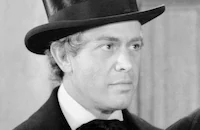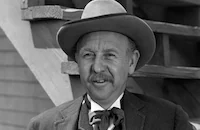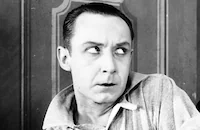Swing High, Swing Low

Brief Synopsis
Cast & Crew
Mitchell Leisen
Carole Lombard
Fred Macmurray
Charles Butterworth
Jean Dixon
Dorothy Lamour
Film Details
Technical Specs

Synopsis
Maggie King, a passenger on a cruise ship passing through the Panama Canal, flirts with Skid Johnson, a soldier on his last patrol. While ashore, Skid drives Maggie and her friend Ella into Panama City and introduces them to his roommate, Harry, a hypochondriac. When a Panamanian harasses Maggie at a nightclub, Skid picks a fight, and both he and Maggie land in jail. They appear before a judge the next morning, but Maggie's ship sails without her, so she moves in with Harry and Skid. Skid gambles away his trumpet, but Maggie poses as his wife and convinces Murphy, the owner of a café/bar, to give her five dollars to buy Skid's trumpet and to hire him to play at the club. Murphy hires both of them, and they perform successfully together, their biggest hit being a composition by Harry and Skid. After Maggie threatens to leave because Skid spent the night with Anita Alvarez, he proposes to her, and they plan to marry after the evening's performance. Harvey Howel, Maggie's suitor from California, acts as witness to the wedding. At Christmas-time, a New York agent persuades Skid to take a job in New York at the El Greco, where Anita has been performing. Skid becomes the toast of New York, and due to Anita's attentions, neglects to send funds back to Panama for Maggie's passage to New York. Maggie borrows money from Murphy and sends a telegram to Skid, but Anita intercepts it and throws it out, thus Maggie arrives in New York with no one to meet her. She calls Anita's room and Skid picks up the telephone, having fallen asleep on the couch in a drunken stupor. Broken-hearted, Maggie files for divorce, and Skid loses all interest in his career and life. Later, a newspaper clipping announces the engagement of Maggie to her former suitor, Harvey. Skid becomes a bum, but as a last ditch effort, Harry, who has married Ella and moved to New York, arranges to have Skid play on a live radio broadcast. Skid's agent Georgie convinces Maggie to show up, and despite his deteriorated state, Skid manages to pull himself together when Maggie joins him on stage to sing their old favorite.

Director

Mitchell Leisen
Cast

Carole Lombard

Fred Macmurray

Charles Butterworth

Jean Dixon

Dorothy Lamour

Harvey Stephens

Cecil Cunningham

Charles Arnt

Franklin Pangborn

Anthony Quinn

Charles Judels

Bud Flanagan
Harry Semels
Ricardo Mandia
Enrique De Rosas
Chris Martin
Charles Stevens
Ralph Remley
George Jiminez
Al Morro
Martha Arcos
Crew
Edgar Anderson
Travis Banton
Phil Boutelje
Phil Boutelje
Sam Coslow
Walter Deleon
Hans Dreier
Pat Drew
Farciot Edouart
Ernst Fegte
Ralph Freed
A. E. Freudeman
Oscar Hammerstein Ii
Earl Hayman
Arthur Hornblow Jr.
Don Johnson
Charley Kisco
Burton Lane
Francis Martin
Percy Morris
Boris Morros
Julian Oliver
Leroy Prinz
Ralph Rainger
Leo Robin
Al Siegel
Al Siegel
Ted Tetzlaff
Virginia Van Upp
Eda Warren
Victor Young
Adolph Zukor

Film Details
Technical Specs

Articles
Swing High, Swing Low
The story begins on a cruise ship passing through the Panama Canal, where part-time hairdresser Maggie King starts trading banter with Skid Johnson, a GI who'll return to small-time jazz playing after his discharge from the army in a few hours. She doesn't much like him, but he wheedles his way into her company by posing as a tour guide, and soon they're partying at a nightclub where Skid starts a brawl to make a masher stop pestering her. Next stop: jail and the local courthouse, where they're delayed long enough for Maggie to miss her ship's departure time. Stuck with no place to stay, she moves into the decrepit house that Skid shares with his friend Harry, a piano player. Maggie now begins to realize that the nightclub brawl wasn't entirely a result of chivalry on Skid's part he's polite and charming when he wants to be, but he also has a lot of bad habits, such as drinking and fighting and gambling. Hoping to boost his self-respect and jump-start his musical career, Maggie talks a saloonkeeper into hiring him as an act, and then she joins him on the bandstand, crooning a tune that Skid and Harry wrote in a rare moment of inspiration. A crisis looms when Skid gets too chummy with Anita Alvarez, an old flame of his, but all seems well when he proposes to Maggie and she accepts.
The future looks even brighter when Skid gets an offer to play in a sophisticated New York nightspot. Maggie pushes him to take the gig, promising to follow him as soon as he's successful enough to send for her. He heads north without delay, and a few eighth notes later he is Manhattan's biggest trumpet star. But there's still a cloud on the horizon: Anita Alvarez, who's appearing at the same New York nitery where Skid now plays. Hoping to steal him away from Maggie, she joins him in his drinking, encourages his gambling, and eggs on his irresponsibility, distracting him so much that he fails to send Maggie the boat fare she needs to join him. Maggie borrows the money and comes to New York on her own, sending Skid a telegram to say she's on her way. Anita intercepts the telegram and lures Skid into her hotel room; when Maggie calls up Anita to ask where he might be, the drunken trumpeter comes out of his alcoholic haze just long enough to answer the phone. The sound of his voice confirms Maggie's worst fears, and the rest of the story unfolds along familiar lines: Maggie demands a divorce, Skid goes on the skids, a friend gives him one last shot at success, and a final reprise of the special song accompanies a semi-happy ending in a decidedly minor key.
Swing High, Swing Low was the second movie adaptation of the stage play Burlesque; it was preceded in 1929 by The Dance of Life, where Skid was a dancer and comedian played by Hal Skelly, and it was followed by a 1948 remake, When My Baby Smiles at Me, with Dan Dailey and Betty Grable as troubled vaudevillians. Paramount wanted Irene Dunne and Gary Cooper to star in the 1937 production, but when Cooper demurred his part went to Bing Crosby in that draft of the screenplay Skid was a singer and then to MacMurray, who had worked well with Lombard in Hands Across the Table (1935) and The Princess Comes Across (1936) and would appear with her again in True Confession, another 1937 release. Paramount put solid resources into Swing High, Swing Low, signing the meticulous Mitchell Leisen to direct it and sending a technical crew on a two-month jaunt to Panama City for research before constructing the sets, which look reasonably authentic apart from some cheesy rear-projection scenes. MacMurray's mellow trumpet tones were provided by two members of Victor Young's orchestra, and Leisen took unusual care to match the musicians' on-screen "playing" with the overdubbed music on the soundtrack. The studio's investments of time and talent paid off nicely, making the picture one of the year's most profitable entries.
Although the play it's based on had its Broadway run in the 1927-28 season, before anyone knew a Great Depression was just around the corner, the mood of Swing High, Swing Low resembles that of other 1930s musicals the classic 42nd Street and Gold Diggers of 1933, for instance that combine feisty dialogue and catchy tunes with a Depression-era anxiety that festers beneath the surface and eventually bursts into the open. The opening scenes are pure screwball comedy, but it isn't long before Skid's dark side starts creeping into view, and just when you think Maggie has done away with his inner demons, they race right back and ruin everything in sight.
The film's most powerful scene is also the strangest: Maggie is mourning the death of their marriage when Skid barges into her hotel room, not alone and repentant but surrounded by friends and bursting with neurotic energy, chattering and joking as if a hefty drink and a raucous laugh were all he needed to win her back again. The subsequent scenes of Skid's decline seem tame by comparison, yet MacMurray's heartfelt acting and Lombard's quiet sensitivity make even these convincing. Important contributions also come from Charles Butterworth as Harry the pianist, a guy so laid back that Hoagy Carmichael seems edgy by comparison, and from Dorothy Lamour as Anita the home wrecker. (This was only Lamour's second movie, and Lombard immediately packed her off to makeup wizard Wally Westmore for emergency eyebrow work.) Anthony Quinn plays the Panamanian cad who goads Skid into the nightclub brawl, and Franklin Pangborn is his usual inimitable self as a harried hairdresser. Lending additional spice are Ted Tetzlaff's smooth camerawork and musical numbers by several good songwriters.
Burlesque was a prestigious Broadway hit in its day, starring Barbara Stanwyck and Oscar Levant in its original run and returning in 1946 with Bert Lahr and Jean Parker in the leads. But even with those credentials, it's hard to imagine the play being as odd and interesting as its 1937 screen version. MacMurray wasn't much of a dancer, but his chemistry with Lombard is fascinating to behold.
Producer: Arthur Hornblow, Jr.
Director: Mitchell Leisen
Screenplay: Virginia Van Upp and Oscar Hammerstein II, based on a play by George Manker Watters and Arthur Hopkins
Cinematographer: Ted Tetzlaff
Film Editing: Eda Warren
Art Direction: Hans Dreier, Ernst Fegté
Music: Victor Young, Phil Boutelje Songwriters: Ralph Rainger, Leo Robin, Sam Coslow, Al Siegel With: Carole Lombard (Maggie King), Fred MacMurray (Skid Johnson), Charles Butterworth (Harry), Jean Dixon (Ella), Dorothy Lamour (Anita Alvarez), Harvey Stephens (Harvey Howell), Cecil Cunningham (Murphy), Charles Arnt (Georgie), Franklin Pangborn (Henri), Anthony Quinn (The Don), Charles Judels (Tony).
BW-83m.
by David Sterritt

Swing High, Swing Low
Quotes
Trivia
Notes
The working title of the film was Morning, Noon and Night. This was Carole Lombard and Fred MacMurray's third film together. The Paramount script files at the AMPAS Library provide the following information about the production: In April 1936, Oscar Hammerstein II completed an early treatment based on the play Burlesque called Hot Trumpet, which slated Una Merkel, Lynne Overman and Rita Rio for roles in the film. The Censorship Dialogue Script, dated February 27, 1937, gave a length of 11 reels and 9,472 ft., while the Release Dialogue script, dated March 6, 1937 shows a length of ten reels. The negative cost of the film was $739,620.99. A pressbook notes this is the first film in which Carole Lombard tap dances. She learned to tap dance specifically for this role under the tutelage of Le Roy Prinz. In addition, Lombard received vocal coaching from Al Siegel. Assistant director Edgar Anderson took the technical crew to Panama City for two months to gather information for building the set. According to Variety, Frank Zinziv and William Candreva of Victor Young's orchestra played trumpet for MacMurray. Swing High, Swing Low was a top moneymaker in 1936-37. Paramount's 1929 The Dance of Life was based on the same source and was directed by John Cromwell and Edward Sutherland and starred Hal Skelly and Nancy Carroll (see AFI Catalog of Feature Films, 1921-30; F2.1141). Paramount later sold the rights to the play Burlesque to Fox, who made When My Baby Smiles At Me starring Betty Grable, Dan Dailey and Jack Oakie in 1948. Modern sources note that Irene Dunne and Gary Cooper were initially slated to play the leads, but Cooper declined the role. Bing Crosby stepped into the role of Skid as a singer, but was replaced by Fred MacMurray. Dorothy Lamour also notes that Wally Westmore assisted with her make-up on Carole Lombard's bidding, and that during this production, she left the set to do retakes for Jungle Princess.

Miscellaneous Notes
Released in United States 1937
Released in United States March 31, 1987
Shown at San Francisco International Film Festival March 31, 1987.
Released in United States 1937
Released in United States March 31, 1987 (Shown at San Francisco International Film Festival March 31, 1987.)













